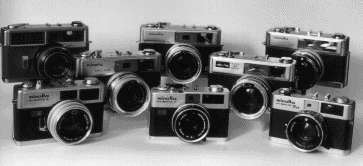
Minolta Hi-Matic Range Finder Cameras - 1962-1978

Family Portrait - left to right,
Rear:
Hi-Matic, Hi-Matic 7, Hi-Matic 7sMiddle:
Hi-Matic 9, Hi-Matic 11Front:
Hi-Matic E, Hi-Matic F, Hi-Matic 7sII
not pictured
Non-range finder Hi-Matics: Hi-Matic 5, Hi-Matic C, and Hi-Matic G.
Introduced in 1962, the Minolta Hi-Matic was a full sized 35mm camera with a coupled range finder for its 45 mm f2.8 lens. It was also available with a 45mm f2.0 lens. Reasonably successful, it was also sold under the name Ansco Autoset.
It provided full automatic exposure by means of a selenium cell meter and a needle capture exposure system. In automatic mode the camera sets both shutter speed and aperture by a needle capture mechanism that locks the meter needle of the selenium light meter. The meter requires no battery. Apertures may also be set manually against a fixed shutter speed of 1/60 th of a second. The camera must be cocked before changing modes.
The body is chrome with a gray imitation leather covering and a black plastic focusing ring. It has a front mounted shutter release with an auxiliary threaded socket on the top plate for accepting a cable release. The PC flash contact is on the lower front of the body. The self timer is on the lens barrel.
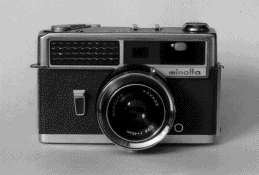
|
The Hi-Matic has a special place in history. John Glen carried a modified version of the Minolta Hi-Matic with him aboard his Mercury Capsule when he made the first manned orbit of the earth by an American in 1962. The modifications involved a handle and enlarged wind lever and trigger shutter controls. The camera was operated inverted using an auxiliary, folding viewfinder mounded on the bottom of the camera. The camera is still on exhibit at the United States National Air and Space Museum of the Smithsonian Institute in Washington, D.C. |
|
|
Modes |
Lens |
View Finder - range finder |
|
NC Auto /Manual |
45 mm f2.8 |
Pink-Green Tinted range finder |
|
Features |
or 45mm f2.0 |
Meter Needle |
|
Acc. Shoe |
Over-Under Exposure Zones |
|
|
PC Contact |
||
|
Self Timer |
|
Shutter Type |
Citizen UNI-E, Mechanical |
|
Shutter Speeds |
B 1/30 1/60 125 1/250 |
|
Aperture Range |
f2.8 <---------->f16 |
|
Meter Range |
EV 8.0 <---------->EV 16 |
|
Meter Type |
Selenium, No Battery Required |
|
ASA Range |
6 . 12 . 25 . 50 . 100 . 200 . 400 . 800 . 1600 |
|
DIN Range |
9 . 12 . 15 . 18 . 21 . 24 . 27 . 30 . 33 |
Introduced in 1962 the Minolta Hi-Matic 7 was a full sized 35mm camera with a coupled range finder and a 45 mm f1.8 lens. It was a completely different camera from the original Hi-Matic/Ansco Autoset. It allowed full automatic operation or metered manual by means of a Light Value system with LV numbers visible in the viewfinder and displayed in a window to a scale on the lens barrel. It employed a Cadmium Sulfide meter cell that was more sensitive than the Selenium meter of the original Hi-Matic but that requires a 1.35v mercury battery. These batteries are now hard to find in the USA due to concerns about mercury batteries being discarded into the environment. The shutter release was moved to the top of the camera and is threaded to accept a cable release.
The chassis of the Hi-Matic 7 served as the basis for the subsequent models 7s, 9 and 11. The body is slightly larger and better finished than the Hi-Matic and is covered with a black imitation leather rather than gray. The wind lever requires a slightly longer arc than the Hi-Matic but can be operated in several short strokes, which made it seem more "professional" although still very much an amatuer's camera.
All four models employed Seiko shutters with top speeds of 1/500th. However; they also used a needle capture automatic exposure system that effectively limited to top speed to 1/250 (at f16). The 1/500th speed could be selected in manual mode. All were equipped with a self-timer (mounter on the lens barrel) which provides approximately 15 seconds delay. The self timer only works in the manual exposure mode. The 7 and 7s have a PC flash contact on the lens barrel.
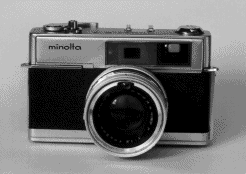
|
Modes |
Lens |
View Finder - Range finder |
|
NC Auto / MM |
45 mm f1.8 |
Pink-Green Tinted Range finder |
|
Features |
6 Elements |
Meter Needle > Exposure Values |
|
Acc. Shoe |
5 Groups |
Over-Under Exposure Zones |
|
PC Contact |
52° view angle |
Moving Parallax Correction Frame |
|
Self Timer |
55 mm filter |
|
Shutter Type |
Sheikosha -LA, Mechanical |
|
Shutter Speeds |
B 1/4 1/8 1/15 1/30 1/60 125 1/250 1/500 |
|
Aperture Range |
f1.8 <----------------->f22 |
|
Meter Range |
EV 5.7 <----------------->EV 17 |
|
Meter Type |
CdS powered by 1-PX625 or PX-13, 1.35v Hg Cell |
|
ASA Range |
25 . 50 . 100 . 200 . 400 . 800 |
|
DIN Range |
15 . 18 . 21 . 24 . 27 . 30 |
The Hi-Matic 7s of 1966 was a modest improvement over the Hi-Matic 7. It added a 'hotshoe' (in addition to the PC contact on the lens barrel) and 'Safe Load System' SLS indicator to show that film was being transported properly. It also claimed to use the Contrasting Light Compensation System'. The range finder windows changed from a contrasting 'pink and green' tint to 'yellow and blue'. The carrying strap lugs were moved up to the side and given a more rounded shape. The end of the lens barrel is black rather than brushed aluminum, as with the model 7. There was also a black model produced which is now quite rare.
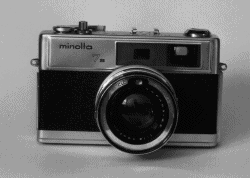

|
Modes |
Lens |
View Finder - range finder |
|
NC Auto /Manual |
45 mm f1.8 |
Blue-Yellow Tinted range finder |
|
Features |
6 Elements |
Meter Needle > EV's |
|
Hot Shoe & PC |
5 Groups |
Over-Under Exposure Zones |
|
Self Timer |
52° view angle |
Moving Parallax Correction Frame |
|
SLS CLC |
55 mm filter |
|
Shutter Type |
Sheiko -LA, Mechanical |
|
Shutter Speeds |
B 1/4 1/8 1/15 1/30 1/60 125 1/250 1/500 |
|
Aperture Range |
f1.8 <----------------->f22 |
|
Meter Range |
EV 5.7 <----------------->EV 17 |
|
Meter Type |
CdS powered by 1-PX625 or PX-13, 1.35v Hg Cell |
|
ASA Range |
25 . 50 . 100 . 200 . 400 . 800 |
|
DIN Range |
15 . 18 . 21 . 24 . 27 . 30 |
The Hi-Matic 9, introduced in 1966 (along with the Hi-Matic 7s) was a slight improvement on the Hi-Matic 7s. It has all of the features of the Hi-Matic 7s plus 'Easy Flash', a system which allows the photographer to set the Guide Number of the Flash on the lens barrel. The camera then adjusts the aperture for correct flash exposure as the camera is focused. Aperture and Shutter speed controls move in opposite directions compared to the Hi-Matic 7 and 7s.
It also uses an improved 45mm f1.7 lens reported to be better than the 7 and 7s' f1.8 lens. Both lenses are given the designation 'PF'' indicating 6 elements in 5 groups. The f1.8 lens is prone to flare and loses contrast in bright sun. The improved performance and very slight speed increase to f1.7 may simply be due to improved lens coating on the later cameras, but why this would not have been added to the 7s is unclear. Both cameras were introduced in the same year.
Other slight differences include: The PC contact was moved from the lens barrel to the side of the body beneath the rewind knob. The shutter an aperture rings move in opposite directions from those on the 7 and 7s. This was probably required to permit the 'Easy Flash' system to operate the aperture while maintaining the same focusing direction in the lens mount.
The end of the lens barrel returned to brushed aluminum as in the 7. Overall; it has probably the best combination of features of the HiMatic 7-11 series full sized cameras.
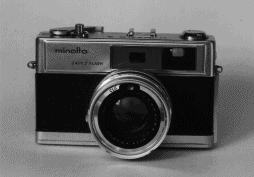
|
Modes |
Lens |
View Finder - range finder |
|
NC Auto / MM |
45 mm f1.7 |
Blue-Yellow Tinted range finder |
|
Features |
6 Elements |
Meter Needle > EV's & BC |
|
Hot Shoe & PC |
5 Groups |
Over-Under Exposure Zones |
|
Self Timer |
52° view angle |
Moving Parallax Correction Frame |
|
SLS CLC |
55 mm filter |
|
|
"Easy Flash" |
|
Shutter Type |
Sheiko -FLA, Mechanical |
|
Shutter Speeds |
B 1 1/2 1/4 1/8 1/15 1/30 1/60 125 1/250 1/500 |
|
Aperture Range |
f1.7 <------------------>f22 |
|
Meter Range |
EV 5.5 <------------------>EV 17 |
|
Meter Type |
CdS powered by 1-PX625 or PX-13, 1.35v Hg Cell |
|
ASA Range |
25 . 50 . 100 . 200 . 400 . 800 |
|
DIN Range |
15 . 18 . 21 . 24 . 27 . 30 |
The Hi-Matic 11, introduced in 1969, has all the features of the Hi-Matic 9 except for metered manual mode. Instead it allows shutter priority automatic or full automatic. It also has fewer low end shutter speeds, only to 1/8th of a second. the Auto mode or shutter speed can be read off the lens barrel thorough the viewfinder. The meter needle indicates aperture values rather than light values (all previous models showed LV numbers).
The minimum shutter speed is 1/8th (rather than 1/4) as with the previous models. There is no aperture control ring. This model effectively has no manual mode (although the shutter operates). The aperture is set by the needle capture mechanism. Without battery the aperture defaults to f1.7. Because of its lack of manual mode the 11 is less versatile a camera than the 9 or 7s.
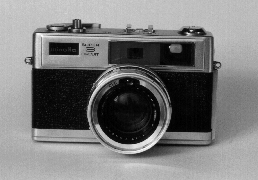
|
Modes |
Lens |
View Finder - range finder |
|
NC Auto / SP Auto |
45 mm f1.7 |
Blue-Yellow Tinted range finder |
|
Features |
6 Elements |
Meter Needle > f #'s, BC, flash |
|
Hot Shoe & PC |
5 Groups |
Over-Under Exposure Zones |
|
Self Timer |
52° view angle |
Moving Parallax Correction Frame |
|
SLS CLC |
55 mm filter |
Shutter speeds visible in corner |
|
"Easy Flash" |
||
|
Shutter Type |
Sheiko -ALA, Mechanical |
|
Shutter Speeds |
B 1/8 1/15 1/30 1/60 125 1/250 1/500 1/500 |
|
Aperture Range |
f1.7 <------------------>f22 |
|
Meter Range |
EV 5.5 <------------------>EV 17 |
|
Meter Type |
CdS powered by 1-PX625 or PX-13, 1.35v Hg Cell |
|
ASA Range |
25 . 50 . 100 . 200 . 400 . 800 |
|
DIN Range |
15 . 18 . 21 . 24 . 27 . 30 |
The Hi-Matic C, introduced in 1971, is a compact lightweight camera. Probably intended to compete with the half-frame 35mm cameras that were being introduced at the time. It however used the full 35mm frame. It featured a pop-up lens that only reduced it's thickness by about 1/2 an inch. It has only one operating mode which is essentially shutter preferred auto. It has only two shutter speeds, 1/30 (marker with a cloud) and 1/250 (marked with a sun icon). It has no range finder. Symbols for the three focus zones are visible in the lower right corner of the viewfinder. The are a 'head and shoulders' for 4 feet (1.2m), 'a group of people' for 12 feet (4m) and a 'mountain' for infinity. A fourth zone equal to a distance of 3 feet or 0.9 m has no icon. The needle indicates aperture. The Hi-Matic C was the first Hi-Matic to have extensive use of plastic parts.
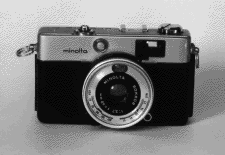
|
Modes |
Lens |
View Finder - Scale Focus |
|
SP Auto |
40 mm f2.7 |
Clear - Zone Focus |
|
Features |
Meter Needle > f numbers |
|
|
Hot Shoe & PC |
Over-Under Exposure Zones |
|
|
"Pop-Up" lens |
57° view angle |
Fixed Parallax Marks |
|
"Easy Flash" |
49 mm filter |
Focus zones visible in corner |
|
Shutter Type |
Sheiko Mechanical |
|
Shutter Speeds |
1/30 ...............1/250 |
|
Aperture Range |
f2.7<------------->f16 |
|
Meter Range |
EV 7.9 <-------------->EV 17 |
|
Meter Type |
CdS powered by 1-PX675 1.35v Hg Cell |
|
ASA Range |
25 . 50 . 100 . 200 . 400 |
|
DIN Range |
15 . 18 . 21 . 24 . 27 |
|
Modes |
Lens |
View Finder - Scale Focus |
|
40 mm f2.7 |
Scale Focus |
|
|
Features |
||
|
57° view angle |
||
|
49 mm filter |
|
Shutter Type |
Sheiko Mechanical |
|
Shutter Speeds |
1/30 ..............1/250 |
|
Aperture Range |
|
|
Meter Range |
|
|
Meter Type |
|
|
ASA Range |
|
|
DIN Range |
The 1971 Hi-Matic E was a fully automatic camera with a wide range electronic shutter and a fast 40mm f1.7 lens. It also allowed both easy flash and manual fill flash modes. The back has a table for converting flash guide numbers to an alphabetic version of the 'easy flash' system. It was completely dependent upon it's two RM640 batteries (Mercury Cells, now hard to find). It has no manual mode or mechanical speeds. When the batteries are dead the camera ceases to operate. It has a battery check light. Alkaline substitute cells will sometimes illuminate the BC light even when they don't have enough power to operate the camera. Wait for a steady light. If it is weak or flickers the cells are too weak. It also has no true diaphragm. The shutter blades form the aperture. It is the last to employ a moving parallax compensation frame. All subsequent models used a simpler set of fixed marks representing parallax at infinity and .9 meters.
Hi-Matic E's and F's are often found inoperative due to corroded battery compartments. These can often be repaired by simply cleaning out the compartment. Sometimes contacts have to be resoldered. In proper operating condition both the E and F are capable of producing fine pictures (if you can live with the lack of manual control).
Despite its dependence on hard to find batteries and lack of manual control the E is a wonderful camera to use. It is exceptionally quite, provides very accurate exposures and has an outstanding lens. Some have suggested that the 40mm f1.7 employed by the E was the basis for the 40mm f2.0 Rokkor (aka the 40mm f2.0 Summicron-C) that Minolta built for use with the Leica CL. This seems unlikely. The design clearly predates the Leitz-Minolta partnership, but is known that Leitz originally intended to market the CL with a 40 mm f 2.8 lens and that Minolta proposed an f2.0 design. The f2.0 lens was deemed adequate in performance to bear the Leica name and was also considered more attractive the the upscale amatuer market for which the CL was intended.
The CL as it turned out was about the same size as the Hi-Matic E. The similarities end there. The E was a nicely made camera and may have helped convince Leitz that Minolta was up to the task of producing the CL, but there are no common parts to speak of.
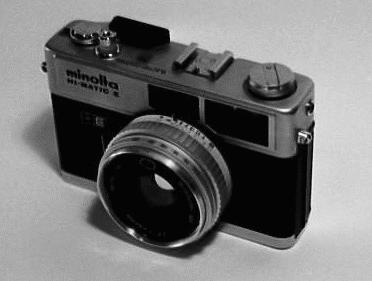
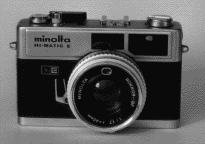
|
Modes |
Lens |
View Finder - range finder |
|
Auto Program |
40 mm f1.7 |
Blue-Yellow Tinted range finder |
|
Features |
6 Elements |
Moving Parallax Correction Frame |
|
Hot Shoe & PC |
4 Groups |
Low Shutter speed & Flash Ready light |
|
Self Timer, SLS |
57° view angle |
|
|
"Easy Flash" |
49 mm filter |
|
|
"Fill Flash" |
|
Shutter Type |
Sheiko -ESF, Programmed Electronic |
|
Shutter Speeds |
2 sec. <-------------------------------------------------------------->1/1000 |
|
Aperture Range |
f1.7 <----------------->f11 |
|
Meter Range |
EV 0.5 <--------------------------------->EV 17 |
|
Meter Type |
CdS powered by 2-RM640 1.4v Hg Cells |
|
ASA Range |
25 . 50 . 100 . 200 . . 500 |
|
DIN Range |
15 . 18 . 21 . 24 . . 28 |
The Hi-Matic F, introduced in 1972 is a scaled down version of the Hi-Matic E. It has most of the same features except for a smaller 38mm f2.7 lens on a more compact body. The shutter offers slightly less range in speeds. It also continues to sound as if it is working even when the batteries are dead too weak to actually work. Use the battery check light.
It usually came with the Auto-Electroflash P, but can work with any type of flash. Like the E it has GN settings for easy flash operation. Unlike the E it uses the actual guide numbers in feet or meters rather than the letter scale (this is much simpler and easier to use).
Parallax compensation in the viewfinder is by fixed marks only, there is no moving frame. There was also a black version called the Hi-Matic FP (the 'P' may be because in the 70's black seemed to be more "professional" than chrome).
Like the E, the F is easily done in by a corroded battery compartment (but can often be coaxed back to life by a good cleaning of the contacts). One in good working condition is a fine pocketable camera for carrying around for snapshots. Its main drawbacks are the total lack of any manual exposure control and total dependence upon batteries. The f2.7 lens a very good performing lens.
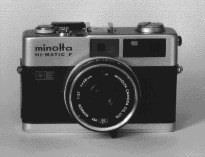
|
Modes |
Lens |
View Finder - range finder |
|
Auto Program |
38 mm f2.7 |
Blue-Yellow Tinted range finder |
|
Features |
4 Elements |
Fixed Parallax Correction Marks |
|
Hot Shoe & PC |
3 Groups |
Low Shutter speed & Flash Ready light |
|
"Easy Flash" |
61° view angle |
|
|
SLS |
46 mm filter |
|
Shutter Type |
Sheiko -ESL, Programmed Electronic |
|
Shutter Speeds |
4 sec. <---------------------------------------------------------->1/724 |
|
Aperture Range |
f2.7 <---------------->f13 |
|
Meter Range |
EV 0.9 <------------------------------->EV 17 |
|
Meter Type |
CdS powered by 2-RM640 1.4v Hg Cells |
|
ASA Range |
25 . 50 . 100 . 200 . . 500 |
|
DIN Range |
15 . 18 . 21 . 24 . . 28 |
The Hi-Matic G, introduced in 1974 is similar in appearance and size to the Hi-Matic E. It has no range finder and uses a simpler 38mm f2.8 lens. It has a hole in the tope plate where the F's rangefinder is located but on the G it is covered only with a transluscent plastic cover that transmits the light to illuminate the bright frame in the viewfinder. Focus is by scale or by four click-stopped zones marked with icons on the lens barrel (not visible from the viewfinder). Its only operating mode is a full automatic needle capture mode. Shutter and aperture combinations are fixed and are indicated by the needle in the view finder. The Shutter is mechanical and operates without batteries at about 1/30th. It usually came with the Auto-Electroflash P, but can work with any type of flash. and has GN settings for easy flash operation.
The 38mm f2.8 lens is totally different from the 38mm f2.7 lens of the F. It has 3 elements in two groups and the shutter is behind the lens rather than between the lens as in the F. Despite its simpler construction the 38mm f2.8 performs on par with that of the F (some say it's better). The lens, shutter and indeed the entire camera bear a striking resemblance to the Konica C35 (with which it was a contemporary) these components (or even the entire camera) may have been produced by for Minolta by Konica.
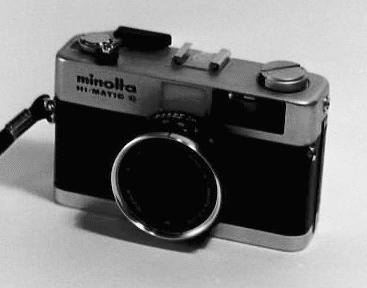
|
Modes |
Lens |
View Finder - Scale Focus |
|
Auto Program |
38 mm f2.8 |
Clear Scale Focus - |
|
Features |
Fixed Parallax Marks |
|
|
Hot Shoe & PC |
Aperture & Shutter speed in viewfinder |
|
|
61° view angle |
Focus scale not visible in view finder |
|
Shutter Type |
Seiko |
|
Shutter Speeds |
1/30<----------------------->1/650 |
|
Aperture Range |
f2.8<----------------->f14 |
|
Meter Range |
EV 8.0 <-------------->EV 17 |
|
Meter Type |
CdS powered by 1-PX675 1.35v Hg Cell |
|
ASA Range |
25 . 50 . 100 . 200 . 400 |
|
DIN Range |
15 . 18 . 21 . 24 . 27 |
The Hi-Matic 7sII was introduced in 1977. It was the last of the Hi-Matic Range finders. It has a body about the size of the Hi-Matics F and G, and the 40mm f1.7 lens like that on the Hi-Matic E. It allows shutter priority automatic operation or complete manual operation (no metered manual mode). The shutter is mechanical allowing it to operate on all speeds with or without battery. It has no easy flash system. Instead, it came with a thyristor flash. It can use any type of automatic flash. Slightly louder than the Hi-Matic E it offers a more robust camera that can continue to operate without batteries. Less pocketable than the F (because of the larger lens), it is nevertheless a more reliable camera simply due to its ability to operate manually, and without batteries.
It was intended to operate with a 1.35v PX675 1.35v Mercury cell. These are now hard to find. It is possible to substiture the S-76 1.5v silver oxide cell, or even A675 1.4v hearing aid batteries. The volatges from these substitutes are less stable and not exactly correct and will cause some minor exposure errors (probably only noticeable on slides).
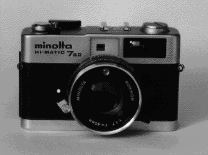
|
Modes |
Lens |
View Finder - range finder |
|
SP Auto / Manual |
40 mm f1.7 |
Blue-Yellow Tinted range finder |
|
Features |
6 Elements |
Meter Needle > f #'s |
|
Hot Shoe & PC |
4 Groups |
Over-Under Exposure Zones |
|
Self Timer |
57° view angle |
Fixed Parallax Correction Marks |
|
49 mm filter |
|
Shutter Type |
Copal, Mechanical |
|
Shutter Speeds |
B 1/8 1/15 1/30 1/60 125 1/250 1/500 |
|
Aperture Range |
f1.7 <------------------>f16 |
|
Meter Range |
EV 5.5 <------------------>EV 17 |
|
Meter Type |
CdS powered by 1-PX675 1.35v Hg Cell |
|
ASA Range |
25 . 50 . 100 . 200 . 400 . 800 |
|
DIN Range |
15 . 18 . 21 . 24 . 27 . 30 |